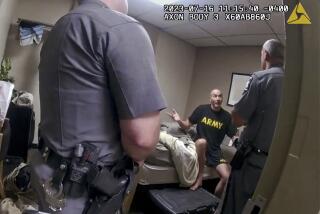Helmet face shield could reduce troop brain injuries
- Share via
The much-maligned combat helmet worn by U.S. soldiers and Marines in Iraq and Afghanistan sustained another blow Monday as engineers from MIT reported that the headgear, as currently designed, did little to protect troops from blast-related brain injury.
But the research team identified a design change that could substantially improve the helmet’s ability to reduce the risk of concussion: a face shield capable of deflecting the rippling force of an explosion away from the soft tissues of the face.
With a shield in place, “you actually do mitigate the effects of the blast quite significantly,” said Raul Radovitzky, lead author of a study published Monday in the online version of Proceedings of the National Academy of Sciences.
The report is not the first to identify the shortcomings of the military’s so-called advanced combat helmet. A study published in August used computer simulations to determine that when blast waves roll over the helmet, the internal pads that are designed to cushion the wearer’s head actually stiffen and transfer concussive energy to the skull and brain, increasing the likelihood of injury.
The new Massachusetts Institute of Technology study contradicted those findings, reporting instead that the helmet doesn’t contribute to brain injury when it is hit by the concussive blast waves of an improvised explosive device.
Radovitzky and colleagues from the MIT Institute for Soldier Nanotechnologies in Cambridge, Mass., and the Defense and Veterans Brain Injury Center at Walter Reed Army Medical Center in Washington, D.C., also relied on computer simulations to gauge the effect of a blast directly in front of a soldier on the “intracranial contents” of a helmet-encased head.
Radovitzky said that in fashioning a computer model of the brain, his team used assumptions about the brain’s structure, density and position within the skull that were more refined and realistic than those used by the authors of the August study.
One of the authors of that report, physicist Eric G. Blackman of the University of Rochester, called the new finding “important.”
“I think it will turn out to be a consideration in the future redesign of helmets,” Blackman said.
Traumatic brain injury, often called TBI or concussion, has become one of the most distinctive and intractable wounds sustained by troops in Iraq and Afghanistan. The armed services have diagnosed more than 188,000 cases among troops who have served in the Middle East.
Many experts think the true toll is far higher, because the effects of brain injury can be easy to miss. The Rand Corp. has estimated that as many as 320,000 service members may have suffered brain injuries in Iraq and Afghanistan.
Brain injuries from explosions during combat appear similar to those that occur in car accidents, falls and sporting events. In most cases, a soldier close to an explosion is thrown against a wall or to the floor, causing “brain whiplash,” said neurosurgeon Jam Ghajar, president of the Brain Trauma Foundation.
But for many troops, brain trauma appears to occur without a direct blow to the head. That mystery has left most experts guessing how, exactly, the damage occurs.
Some speculate that concussive waves of energy pass through the skull and knock the brain around within its cavity. Others suggest an explosion hits the chest with a powerful jolt, setting off sudden changes of blood flow and pressure that harm the brain. An explosion’s light, heat, chemical byproducts or even a sudden surge of electromagnetic energy could possibly disturb and damage the brain.
Running experiments on humans is impractical — hence the need for sophisticated computer simulations. Until medical experts understand how bombs hurt brains, though, the value of those simulations is limited.
“While the work of Radovitzky and others is compelling, these computational models are just that — models,” said Dr. Kenneth C. Curley, director of neurotrauma research for the U.S. Army’s Medical Research and Materiel Command at Ft. Detrick, Md. “Models are only as precise as the data available to drive them.”






